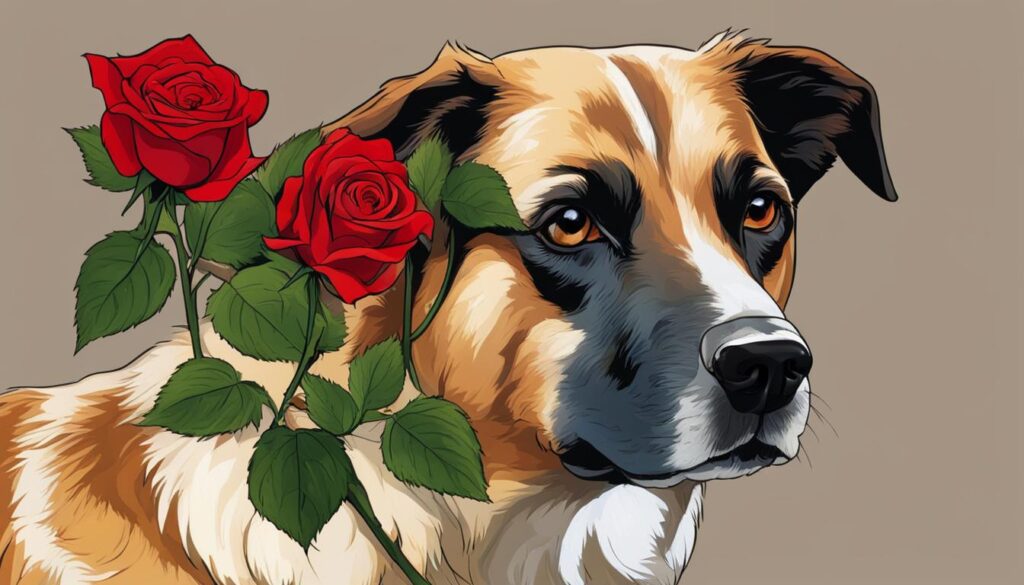Are Roses Poisonous to Dogs? Safety Guide 2023
Roses are a popular flower that many people love to have in their homes and gardens. But if you’re a dog owner, you may be wondering if roses are safe for your furry friend. According to the American Society for the Prevention of Cruelty to Animals (ASPCA), roses themselves are not toxic to dogs. However, there are some important considerations to keep in mind to ensure your dog’s safety around roses.
It’s important to note that while roses are generally safe for dogs, there are certain varieties of roses that can be toxic, especially to cats. Additionally, the thorns on rose stems can pose a risk of injury to your dog’s mouth and paws. In this safety guide, we’ll explore the types of roses that are safe for dogs, the potential risks of roses, and how to keep your dog safe around these flowers.
Key Takeaways:
- While roses themselves are not toxic to dogs, some varieties can be toxic to cats.
- The thorns on rose stems can cause injuries to your dog’s mouth and paws.
- There are other flowers that are safe for dogs, such as gerberas, orchids, and sunflowers.
- Some flowers, like tulips and iris, can be dangerous and poisonous to dogs.
- Take precautions to keep roses and other dangerous flowers out of your dog’s reach.
Safe Flowers for Dogs
While roses themselves are safe for dogs, there are also other flowers that you can confidently include in your garden or bouquet without worrying about their toxic effects on your four-legged friend. Some examples of safe flowers for dogs, according to the ASPCA, include gerberas, orchids, sunflowers, petunias, asters, and lilium. These flowers are not only beautiful, but they also pose no harm to dogs if ingested. However, it’s important to note that while these flowers are considered safe for dogs, they should still be consumed in moderation and should not be a regular part of your dog’s diet.
If you’re looking to brighten up your home or garden with dog-friendly flowers, consider adding these safe options to your floral arrangements. These flowers will not only add color and beauty to your space, but they will also provide a safe environment for your canine companion.
Dangerous Flowers for Dogs
While roses themselves are not toxic to dogs, it’s crucial to be aware of the flowers that can pose a danger to your furry friend. Understanding which flowers are toxic is essential in keeping your dog safe and healthy. Here are some examples of flowers that are poisonous to dogs:
- Tulips
- Iris
- Aloe
- Begonia
- Exotic roses
- Kalanchoe
These flowers can cause various symptoms in dogs, including loss of appetite, vomiting, drooling, uncontrollable urination or thirst, diarrhea, skin irritation, and lacrimation. To prevent any potential harm, it’s best to keep these dangerous flowers out of your dog’s reach, whether it’s in your garden or home.
It’s important to note that this is not an exhaustive list of flowers that are toxic to dogs. If you’re unsure about the safety of a particular flower, consult with your veterinarian before exposing your furry friend to it.
Potential Risks of Roses for Dogs
While roses are generally safe for dogs, it’s important to be aware of the potential risks associated with these beautiful flowers. By understanding these risks, you can take proactive measures to ensure the safety and well-being of your canine companion.
Thorns and Injuries
The thorns on rose stems can cause injuries to your dog’s mouth and paws if they come into contact with them. Dogs are curious by nature and may unknowingly approach roses, resulting in painful thorn pricks. These injuries can lead to discomfort, bleeding, and can even become infected if left untreated. To prevent such accidents, it’s essential to keep roses out of your dog’s reach, especially in areas where they play or explore.
Gastrointestinal Issues
Ingesting large amounts of roses can lead to gastrointestinal problems in dogs. While a small nibble on a rose petal may not cause any harm, consuming a significant quantity can result in digestive disturbances such as diarrhea and vomiting. These symptoms can be distressing for your dog and may require veterinary intervention. To prevent gastrointestinal issues, it’s best to discourage your dog from eating roses and monitor their interactions closely.
Cautions with Chemicals and Pesticides
If chemicals or pesticides were used to grow the roses, they can be harmful to your dog if ingested. Many gardeners use pesticides to protect their roses from pests or diseases. However, these chemicals can be toxic to dogs and can cause adverse health effects if consumed. To safeguard your dog’s well-being, it’s crucial to avoid the use of chemicals and pesticides in areas where your dog has access or has regular contact.
To mitigate the potential risks of roses for dogs, it’s essential to take precautions such as:
- Keeping roses out of your dog’s reach
- Trimming thorns or using thornless rose varieties
- Avoiding the use of chemicals or pesticides in your garden
By following these safety measures, you can enjoy the beauty of roses while prioritizing your dog’s health and safety.

Continue reading to learn more about dog-friendly flowers and essential tips for keeping your dog safe around roses.
Tips for Keeping Your Dog Safe around Roses
To ensure the safety of your beloved dog around roses, here are some essential tips you should follow:
- Keep roses and other potentially dangerous flowers out of your dog’s reach by placing them in elevated areas or using barriers to prevent access. This will minimize the risk of accidental ingestion or injury to your dog.
- If you have rose bushes in your garden, consider trimming the thorns or selecting thornless varieties. By doing so, you can significantly reduce the likelihood of your dog getting pricked and experiencing discomfort.
- Avoid using chemicals or pesticides on your roses. These substances can be harmful to your dog if ingested. Instead, opt for organic and dog-friendly alternatives to maintain a healthy and safe environment for your furry friend.
- Monitor your dog closely if they come into contact with roses. Watch for any signs of discomfort, illness, or adverse reactions. If you notice anything unusual, seek immediate veterinary attention to ensure your dog’s well-being.
By following these dog-friendly gardening tips, you can create a safe and enjoyable space for both you and your canine companion.

Implementing these precautions will provide peace of mind, knowing that your dog can freely explore your garden without encountering any harm. Remember, the key to roses and dog safety lies in proactive measures that prioritize the well-being of your furry friend.
Conclusion
Roses are generally safe for dogs, but it’s crucial to be aware of potential risks and take precautions to ensure your dog’s safety. While roses themselves are non-toxic to dogs, there are certain varieties that can be toxic, especially to cats. Additionally, the thorns on rose stems can pose a risk of injury to your dog’s mouth and paws. By following the tips outlined in this safety guide, you can enjoy the beauty of roses while keeping your dog safe.
Remember to always consult with your veterinarian if you have any concerns or questions about the safety of flowers or plants for your dog. They can provide specific advice based on your dog’s individual needs and health conditions.
In summary, roses can bring joy and beauty to your home or garden without posing significant risks to your dog’s health. However, it is crucial to exercise caution, especially when it comes to choosing the right varieties and ensuring your dog cannot access thorns or ingest harmful chemicals. With proper care and attention, you can enjoy the presence of roses while keeping your furry friend safe and happy.
FAQ
Are roses poisonous to dogs?
No, roses themselves are not toxic to dogs. However, there are certain varieties of roses that can be toxic, especially to cats.
What are some safe flowers for dogs?
According to the ASPCA, safe flowers for dogs include gerberas, orchids, sunflowers, petunias, asters, and lilium.
What flowers are toxic to dogs?
Flowers that are toxic to dogs include tulips, iris, aloe, begonia, exotic roses, and kalanchoe.
What are the potential risks of roses for dogs?
The thorns on rose stems can pose a risk of injury to your dog’s mouth and paws. Ingesting large amounts of roses can also lead to gastrointestinal issues.
How can I keep my dog safe around roses?
To keep your dog safe around roses, keep them out of your dog’s reach, trim thorns or use thornless varieties, avoid using chemicals or pesticides, and monitor your dog closely for any signs of discomfort.
Should I be concerned if my dog comes into contact with roses?
While roses themselves are generally safe for dogs, it’s important to monitor your dog closely for any signs of discomfort or illness. If you have any concerns, it’s best to consult with your veterinarian.
What should I do if my dog ingests toxic flowers?
If your dog ingests toxic flowers, it’s important to seek veterinary attention immediately. Be prepared to provide information about the specific flower your dog ingested.


